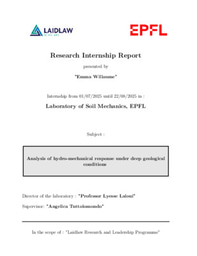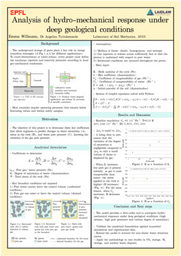Research internship in the laboratory of Soils Mechanics

As most of us know, CO₂ emissions have been at the center of the global debate since 2015, when the Paris Agreement was signed by 196 parties. They agreed on the urgent need to limit global warming to 1.5°C. To achieve this, greenhouse gas emissions were supposed to peak by 2025 and then decrease by 43% by 2030. That was ten years ago, and everyone now realises that this goal is unlikely to be met, unless we all take responsibility and do everything we can to get there.
Many solutions are being explored and implemented, such as renewable energy sources like geothermal energy, nuclear power, and underground CO₂ storage.
All of these technologies have something in common: soils, which are precisely the focus of study in my lab.
-
Geothermal energy harnesses the Earth’s internal heat. A fluid is injected into the ground to absorb this heat, and then brought back to the surface to release it.
-
Nuclear energy does not directly interact with the ground during production, but its waste must be safely stored for millions of years. The best current solution is underground storage. However, the corrosion of metal structures around the radioactive material can generate hydrogen (H₂), which poses its own challenges.
-
CO₂ capture and sequestration involves capturing CO₂, especially from emission hotspots like incineration plants, and storing it in porous underground rock formations.
-
Hydrogen (H₂) production and storage is another promising pathway. To make renewable energy sources less dependent on weather conditions, surplus electricity can be used to produce hydrogen via electrolysis. This hydrogen can then be stored underground and used later, when production drops.
My research focuses on the interaction between injected gases (CO₂ or H₂) and the underground rock. When gas comes into contact with water- and air-filled rock pores, it increases water pressure, which can potentially trigger microseisms, even at significant distances. This is particularly risky near nuclear waste storage sites.
My work aims to determine key coefficients to model these interactions to improve our understanding of pressure build up within reservoirs. For that, I am developing an accurate model and solving the necessary equations using Python. The final goal of my project is to determine three key coefficients that allow engineers to predict changes in: water saturation, pore water pressure and rock stress knowing only the variation of pore gas pressure and some properties of the rock and the gas.
Figures 3.2 and 4.1 from the public report HyUnder – Deliverable 3.1: “Assessment of the potential, the actors and relevant business cases for large scale and seasonal storage of renewable electricity by hydrogen underground storage in Europe” (Grant Agreement No. 303417), published on June 23, 2014. Funded by the European Commission.


Please sign in
If you are a registered user on Laidlaw Scholars Network, please sign in
Amazing post! Your work will help find more efficient solutions to battle global carbon emissions. I look forward to seeing the results of your research! Good luck with your project!
Great post, Emma! I like how you connect geothermal, nuclear, CO₂, and hydrogen storage through underground interactions. It’s impressive how much depends on soil and rock behavior, and how important your modeling is for safety. The part about microseisms near nuclear waste sites really stood out. Can’t wait to see how your work progresses!
Crucial work for the energy transition, both timely and impactful. Can’t wait to see where this leads! Keep going Emma!
Congratulations on this work, Emma! Modeling those interactions sounds complex but crucial, the kind of work that quietly underpins safe, scalable climate solutions. I really like how your research connects multiple technologies under a single framework of subsurface science. Looking forward to future results!
Such an important area of research, Emma! It’s fascinating how soil mechanics sits at the intersection of so many climate solutions and how your work on modelling these interactions directly supports safer, scalable transitions. Excited to see where this leads!
Great research, Emma ! The way you connect soil mechanics with real-world climate and energy challenges is inspiring ! Bravo for this cool work and I'm looking forward to seeing what comes next !